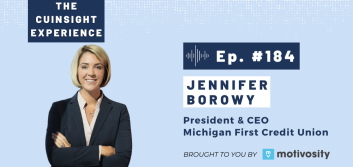Four bookstore strategies your credit union should adopt

Ten-to-fifteen years ago, when my son was young, we spent many evenings at our neighborhood Barnes & Noble bookstores. Grab a pizza and go hangout at “B&N” was a very frequent occurrence. We loved spending hours there; it had so much to do to entertain kids and adults. And, many nights we left having made a purchase or two or three while there.
Since then, Barnes & Noble’s reputation has been battered and bruised and, until recently, many experts feared it wouldn’t survive. The threat of Amazon was unlike anything the industry had ever seen. The pandemic locked people out of their stores for many months – literally and physically. Being in highly-vacant shopping malls hasn’t been a very desirable location, even today.
But Barnes & Noble has survived and, in many ways, is thriving today more than ten years ago. They’ve reinvented themselves as a retailer and consumers seem to like what they’re doing. They’re continuing to modify their business model and hone their marketing approach. And, as a result, their strategies place them on the verge of becoming the next business school story of success.
Selling books is certainly a different world than retail banking but there are many lessons a credit union can learn from what Barnes & Noble (B&N) has done. Here are four you should adopt at your credit union:
- Know your market
If you’re like me, when Amazon skyrocketed to unimaginable heights a handful of years ago, I thought all bookstores were doomed. There’s no way they could compete, right? Of course some have bit the dust but B&N survived in large part because they narrowed their definition of their “customer”. They realized that their customers were not necessarily book-buyers but, rather, book-lovers. Wow, what a key distinction! Today, they accept that the consumer who has to buy just one book will likely go to Amazon. However, the person who is searching for that next book to dive into and immerse into is the consumer they want to capture.
And, for the most part, they’ve been accurate in this new definition of their customer. They’re perfectly fine with you and I spending hours in their store falling in love with two, three, or more books that we end up buying (then or later). They’re confident in believing that their market has such loyalty to B&N that they will keep coming back to fall in love with more books in the future. Book-lovers LOVE the experience in their local B&N store – the interactions with staff, the sensory experience of the music and smell, the comfort of the store layout.
Your credit union has a similar challenge and your strategy should be similar: know precisely who your market is and, equally important, who it isn’t. Be willing to say no to a chunk of your marketplace who doesn’t match your definition. Then create your member experiences around that definition. Like a bookstore, design your branches, contact centers, and digital experiences to fit perfectly into that definition.
- Be local
An overarching goal for B&N is to feel “small”, like the neighborhood, independent mom-and-pop bookstore that so many people love. But that’s hard to do when you have 600 locations world-wide. One significant way they accomplish this is to place trust in the decision-making of their store managers. Those managers should know their markets better than someone in a corporate suite, they reason, and as a result, they give store managers discretion over purchasing, placement, and even pricing.
Managers are expected to maintain a strong connection with their customers, understanding what they want to read, and their communities, gauging how they want to do business. Through activities inside and outside the store, the store managers should have their finger squarely on the pulse of their local market.
This may or may not be true for the managers at your credit union branches today and it’s probably unrealistic to expect them to do it extensively in the future. But someone (an individual or team) needs to know the distinctly unique qualities of each market from the others you serve. And executives need to be willing to make modifications to how each branch functions in order to best serve the members and potential members in their market.
- Be welcoming
As mentioned earlier, B&N has tried to become more and more like the small, independent bookstores that thrive in many communities. That’s hard to do when your immense physical space is often seen as overwhelming by many consumers. But being welcoming is vital to that desired experience and in many cases requires a human touch.
In their stores, employees are trained to hang out near the front door and greet shoppers when they come in. They may not be a “greeter”, per se, but they’re function is similar – dispense a genuine “welcome and thanks for coming in today” to each shopper. They are expected to encourage shoppers to browse for as long as it takes to find the right book as well as walk them to a specific book they may have asked about.
This welcoming feeling is projected by the store’s overall environment, too. From the colors on the wall and materials on the floor to the smells from the coffee shop and the music from the speakers, B&N wants to convey their desire for consumers to come, sit, and enjoy their stay.
Similarly, many consumers can feel uneasiness when walking into a credit union branch. They may be uncomfortable in a big, ornate space; uncertain about whether to go left, right, or straight ahead through the lobby; or unacknowledged by busy employees scurrying past. The immediate sensations they feel are going to set the stage for the quality of their experience with you. A welcoming physical environment buttressed by friendly, acknowledging employees conveys the “come, sit, and enjoy your stay” environment that many consumers desire.
- Hire to fit
It’s more than just ironic that B&N defines their target customer as a “book-lover” because they also define their ideal employee as a “book-lover”. That’s right, they’re looking for many of the same qualities in their employees as they are in their customers. It’s not just enough to hire employees who are friendly and have good service experience (and they’re certainly not looking for typical salespeople); ideally, they hire people who love books and their passion for reading is readily apparent. In that way, they easily relate to the customers they interact with.
B&N employees have extensive knowledge of many books in their store and can, therefore, provide details and recommendations to customers. Because they’re likely thinking from a similar perspective, the employee can often turn customers on to other books and products that may be in a totally different part of the store. They will even leverage their love for reading to organize the bookshelves in such a way that makes book-hunting much more intuitive. Book-lovers, they’ve found, are far more likely to create great experiences for other book-lovers.
At your credit union, hiring employees who have a great love for banking may be a tall order – do people really love banking?! But prioritizing an employee’s love for managing money or investment options or saving for a specific life event or goal may get you pretty close to the B&N model. Afterall, I’m certain your members love their money and would value help with managing, investing, and saving it, too.
You may already have a focus on one or more of these strategies but, going forward, your challenge should become: a) being great at each one, not just good; and b) synthesizing them all into a cohesive and consistent strategic approach. Your members want it. Your employees need it. And your quest for future viability requires it.
If your credit union needs help taking your performance to the next level in any or all of these areas, our consultants are poised to help. Please reach out to www.fi-strategies.com/contact-us or 636-578-3280.





